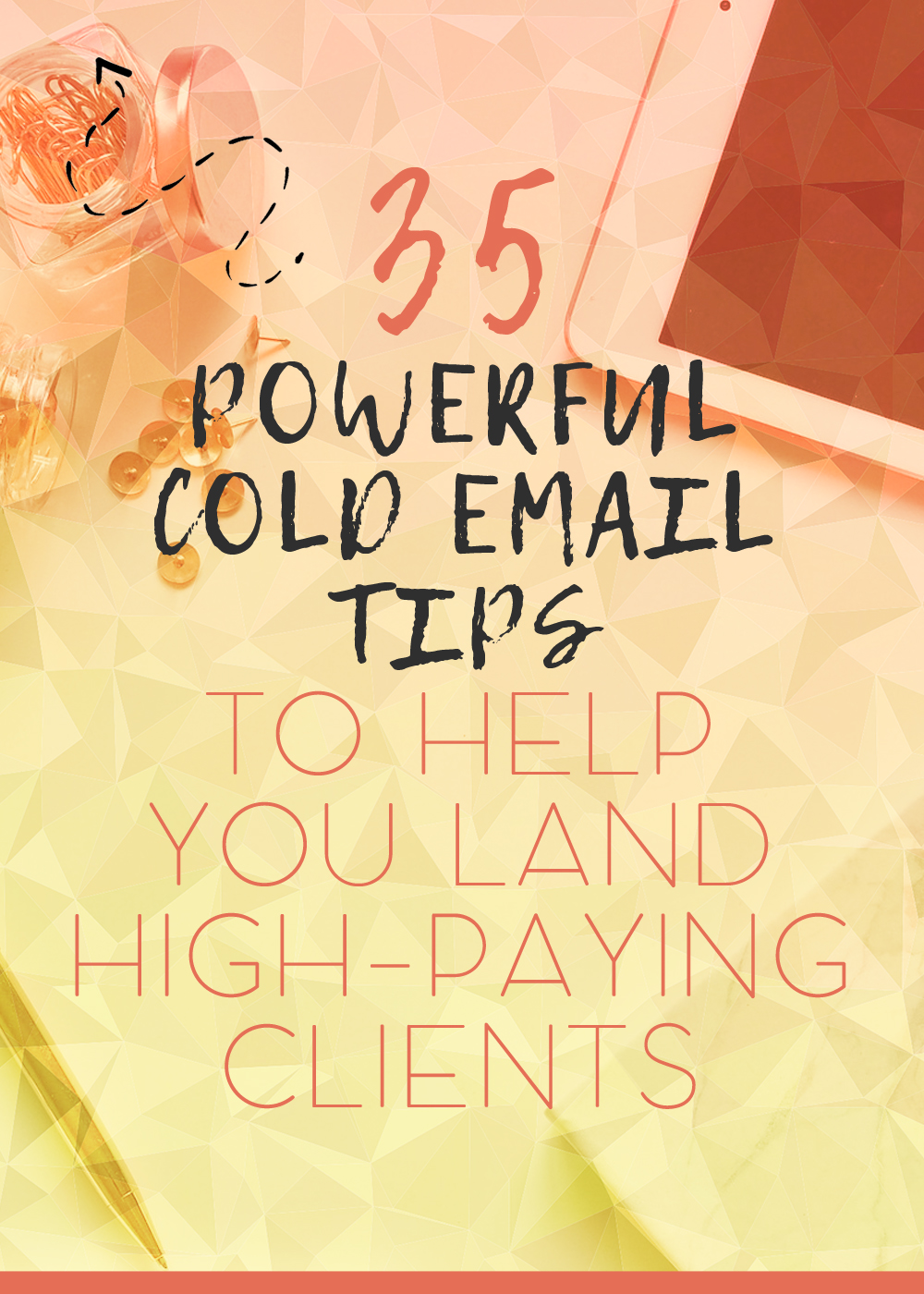Psssttt...

Ready to find high-paying clients and build a profitable business?
Get your free copy of Win More Clients, a 20+ page eBook that shows you how to get paid more and the secret sauce you need to create a sustainable freelance business
You’re facing yet another month with no potential projects in the pipeline.
Your calendar is blank apart from one pencilled in project that you half-heartedly rubbed out last Friday when the client went ghost on you.
You’ve scrolled through your go-to job boards until your fingers hurt and still nothing. Just crickets – in both your inbox and your bank account.
Yes, it sucks.
But it’s all part of being a freelancer.
This whole getting jobs and clients thing is daunting, but it’s a completely vital part about working for ourselves.
Yet, despite the absolute necessity to land clients (because without them, you don’t really have a business), pitching and the ability to successfully write cold emails still eludes even the most experienced freelancer.
Isn’t it about time we changed that?
Hell yeah it is.
For your reading pleasure, and to give you that kick up the behind you need to start writing cold emails today – and not just any cold emails, but the kind that get you high-paying, lovely, wonderful clients – I’ve put together a huge list of cold email tips to send you on your way.

Cold Email Tips Before You Even Begin to Write
1. Laser-Focus Your Targeting
Before you even think about putting pen to paper – or fingers to keyboard – and shooting off a flurry of cold emails, you need to know exactly who it is you’re going to be emailing.
It’s not enough to say “I want to target business owners”.
Think of all the businesses in the world – from small independent florists to international corporations like Amazon. Instead, you want to hone in on the type of people you want to work with.
Get really specific here, too. Do you want to work with single mothers who are juggling two part-time jobs, or do you want to work with multi-million dollars businesses that are looking to globally expand?
2. Batch Find Prospects
It’s really easy to get sucked into the research stage – you know, the endless hours searching Google for your ideal client.
And then you realise you’ve wasted two hours going back to 2010 on the company blog and haven’t even thought about writing the actual email yet.
This is why it’s a really good idea to batch task writing your freelance pitch.
There are several key phases to the process from start to finish, and grouping these together can make it quicker and less choppy.
For example, spend one day finding ideal prospects, spend the next making initial connections on social media with those prospects, and spend the third writing out personalised emails to each and every one of them.
This gets rid of the stop-start nature of running through the process with one prospect and then having to go back and do it all again with another.
3. Gather Key Information
When you’re researching potential prospects, it’s important to gather together key pieces of information about them that you can weave into your cold email.
It’s not just the name of the company and what they do that you need to know, but it’s also things like:
- If you’re a writer, do they already have a blog and what kind of content are they posting there?
- If they’re a designer, what collateral do they already have?
- Who is their target prospect?
4. Make Connections Pre-Pitch
Before you go ahead and send a bunch of strangers an email asking them to work with you, try making an initial connection first.
You might do this by simply responding to one of their Tweets on Twitter, or you might go and watch them do a talk at your local town hall.
Either way, that initial connection will prove incredibly useful when it comes to actually writing your cold email.
Tips for Writing Cold Emails
5. Use the Prospect’s Name
There’s nothing more off-putting than receiving an email from someone who doesn’t know your name.
Those “Dear Sir” emails are the bane of my life (especially because I’m definitely not a “Sir” and a quick look around my site will immediately make people aware of that).
So, you can quickly make yourself stand out by finding the name of your prospect and including it at the start of your cold email.
6. Add Social Proof
Social proof might sound arbitrary, but it can make the difference between a prospect choosing you and going with another freelancer.
You don’t have to whip out jaw-dropping numbers here (and don’t even think about making something up), but if you’ve had any good results or have a nice following on social media somewhere, be sure to mention that in your cold email.
7. Use Humour
We’re all humans trying to find our way in the big, wide world.
Okay, that’s slightly dramatic, but you get the point. When you write cold emails, you’re communicating with another human being, not a robot.
You’d be amazed at the amount of cold emails I get from people who don’t treat me like I’m a person. They use long words and don’t tap into the thing that makes us stand out from all other creatures on earth – our ability to feel.
The easiest way to tap into this is to use humour – don’t go all out on the joke front, but a couple of quirky phrases here and there will do the trick.
8. Be Specific
People are busy. Fact.
If they can’t get the jist of your cold email within the first few seconds, guess where it’s going to end up? You got it – in the trash (a.k.a. The place you really don’t want it to end up).
Don’t drivel on about which school you went to or share your life story. Instead, get right to the point and be specific about why you’re emailing and what the aim of your email is.
9. Use Numbers and Statistics
Numbers are confusing, but there’s one thing they’re really good at and that’s getting across stats in a quick, concise way.
Following on from the idea of adding social proof when you write cold emails, you can also throw in a few numbers and statistics to give your pitch some clout. These might be things like how your content helped increase a brand’s conversions by X% or why brands with an iconic design are more likely to get X more sales each year.
10. Keep it Short and Simple
Again, people are busy.
So as well as getting to the point quickly, keep the rest of your email tight and on-point. Don’t go off on a tangent and make sure you keep it to a maximum of four or five (very) short paragraphs.
Once the prospect has skimmed what you’re offering and responded, then you can go into more detailed if it’s needed.
11. Focus on Results
Remember you’re a stranger to the person you’re emailing.
They don’t care that you drew your pet rabbit when you were fifteen and that’s what got you into illustration. They want to know what working with you will look like for them, so include the results your services get.
This could be something like more conversions, a boost in niche authority, or a surge in speaking opportunities at local charity events.
12. Highlight the Benefits
Too many freelancers focus on the features of their services (“you’ll get two edits”, “I’ll make graphics to go with your blog posts”) as opposed to the benefits (“you’ll get a perfectly polished piece of content” or “stand out with branded graphics for each post to share on social media”).
Really think about what the prospect will get out of working with you rather than a list of what your service includes.
13. Add a One-Liner Intro
When you write cold emails, it’s easy to assume that people will take the time to click through to your website and find out who you are.
Unfortunately, that’s not always true.
Which means it’s important you introduce yourself right away to create an initial human connection and so your prospects know who this email that’s landed in their inbox is from.
Keep it concise, though. A simple one-liner introducing who you are, what you do, and who you do it for should do the trick.
14. Finish With Your Portfolio
The one thing that can make a prospect pick you over your competition is your portfolio.
Now, don’t think you have to have some highly-polished portfolio with examples of work on top sites. You simply need to use it to show that you can do what you say you can do – easy!
It’s always good to directly link to a few pieces, examples, or case studies here rather than linking to your portfolio in general, because very few prospects will actually click through and take a look around all your portfolio pieces. Instead, they’d rather just see one that’s a good fit for them.

15. Add a Call-to-Action
When your prospect gets to the end of your pitch, what do you want them to do?
Most of the time, us humans need a push (or a shove) in the right direction, which means you’ll see more success with your pitches if you actively tell the reader what you want them to do next.
Whether you want them to schedule a time to chat in your online calendar or click through to a case study you’ve sent, make sure it’s clear that you want them to do that.
16. Add in a Unique Touch
People like to feel special.
Your prospects don’t want to feel like you’ve sent out a thousand pitches and they’re just one of many recipients.
They want to feel like you’ve handpicked them especially (which you have, right?!), and you can help that by adding in something unique about them in your pitch.
Maybe you mention the fact you’re from the same place as their founder, or maybe you admit that their blog is your most read on your feed reader.
17. Consider Your Subject Line
Before a prospect even reads your pitch, they’re going to see your email subject line. Which means this might just be the most important thing about your pitch.
If you can’t get someone to open your email, they’re not going to be able to see all the goodness you can offer them. So step number one always needs to be operation open that email!
Rather than putting something like “freelance writer looking for work”, try and tweak it so it’s personal to them; something like “I can help [BRAND] boost their conversions” is a much better go-to subject line.
18. Keep Things Informal
Sure, we’re professionals, but do you know how many jargon-filled emails your prospects are receiving each day?
Chances are it’s a lot.
Which means you’ve got an opportunity to stand out by getting rid of those long words and adding a dose of humanity to your offering. I’m not saying you need to tell them you’re emailing them from your couch in your sweat pants; instead, try dropping the jargon that you think makes you sound clever and see how you get on.
Simple is best – always is and always will be.
19. Don’t Get Too Personal
I just mentioned the fact you might want to skip telling your prospect where you’re emailing them from and what you’re wearing, which is a golden rule to stick by.
While you don’t want to use long words and jargon, you also don’t want to get too personal. You prospect doesn’t care what you had for breakfast or that you’re desperate to pick up a new client – those are things best left rattling around in your brain.

20. Solve a Problem
A lot of freelancers will tell you to focus on what you can do for a prospect and, for the most part, they’re right.
But that’s easier said than done.
We’re usually so wrapped up in our own services and offerings that it’s difficult to see things from the client’s point of view, which is why it can help to think about solving a problem rather than offering a service.
Pitching your offering as the solution to a major challenge or roadblock the prospect is facing is one of the best ways you can sell yourself.
21. Respect the Recipient’s Time
People are getting busier by the day, so it’s important to acknowledge that your prospect doesn’t have all the time in the world to respond to you.
But how do you do this?
Firstly, you can keep your pitch short and concise, and secondly you can be patient when it comes to following up.
Sending a “did you get my message email” a couple of hours after you sent your pitch is a surefire way to get a prospect rolling their eyes and moving your pitch straight into their trash can.
22. Don’t Beat Around the Bush
It can feel cringey pitching your services to a complete stranger, and a lot of freelancers try and make it less cringey by spending ages introducing themselves. While it’s great to make that personal connection early on, you ideally want to get to the point as quickly as possible – remember, people are busier than ever.
A quick sentence introducing yourself is enough, but then move on to why you’re in their inbox.
23. Make Your Request Small
People hate big asks – especially from people they don’t know.
Asking a client to set aside an hour to talk with you just isn’t do-able, but asking them to take 10 minutes out of their day can be done.
Keep your ask (or your call-to-action) small, so the prospect doesn’t feel like the have to jump through hoops to work with you.
24. Don’t be Afraid to Ask
And when it does come down to your “ask”, don’t be scared to put it out there.
It can be tempting to dodge around the point because you don’t want to be seen as too forward or pushy, but that can confuse a prospect and lead them to taking no action at all (because, well, they don’t know what you want them to do).
Instead, make your question or request clear and concise so they know exactly what you’re asking and what their next steps should be.
25. Position Yourself As An Expert
Remember, you’re not a commodity!
You are not selling yourself. Instead, you’re selling a solution to a problem – this is what you’re trying to get prospects to buy into.
The reason businesses hire freelancers in the first place is because they can’t do design, writing, marketing, or whatever themselves. They need your expertise, and that’s what you’re selling.
As soon as you start positioning your offer as a solution to a key problem, the sooner you’ll start seeing results from your pitches.
26. Find Common Ground
I’ve mentioned it so many times before but, as humans, we crave connections with other humans – but, more importantly, we crave connections with other humans who are like us.
We automatically gravitate towards those who have similar interests or fit a similar demographic to us because we can more easily relate to them.
You can use this to your advantage when writing cold emails by slipping in a commonality between you and the client – maybe you grew up in the same place, or maybe you studied the same course or have been to the same event as them.
27. Proofread, Proofread, Proofread
Spelling mistakes and paragraphs that look like they’ve been whacked out in a hurry diminish the credibility of your pitch and will make prospects question whether you’ll overlook details when working for them, too.
If there’s one thing I recommend you do with EVERY SINGLE pitch, it’s go back through and proofread it once, twice, and three times.
Look for spelling mistakes and, if you want to take it a step further, read it out loud to see whether it flows well.
28. Get Creative
Making your pitch stand out in someone’s inbox is all about, well, standing out.
You see stories every day about people who did crazy creative things to land the job of their dreams and, while you don’t have to go all out to get the attention of a prospect, you can shake things up a bit to give yourself a little sprinkle of something different.
Maybe you film a video to go with your pitch, or if you’re a designer, maybe you design a little banner to go with your email.
29. Don’t Be Too Different
That being said, you don’t want to make yourself stand out for the wrong reasons.
Prospects won’t want to watch a 30-minute video all about you, so be selective about when, where, and what you get creative with.
Most of the time, prospects will be checking their inbox quickly, so the main goal is to get them, first of all, to open your cold email, and then to take action on your offer.
30. Combine Two Methods
One of the key pieces of advice I give to my students in Pitch & Prosper is to create connections before you start writing cold emails. This means you’ve made contact with the prospect before you land in their inbox so they know who you are and are already a much warmer lead than if you were to email them out of the blue.
You might want to connect with them on LinkedIn and then shoot them your cold email, or you might connect with them on Twitter first.
I like to call this the double-whammy approach and it leads to tons more success than simply reaching out cold and hoping for the best.
31. Don’t Overthink
Us freelancers are really good at overthinking things – I think it must be the kind of people we are, and this is one of the main reasons why sending cold emails feels like a mammoth task for us.
We forget to think in the moment and instead start filling our heads with questions like:
- What if my pitch isn’t good enough?
- What if I annoy the prospect?
- What if I didn’t send the right portfolio pieces?
It’s this overthinking that leads us to freeze up and not send any cold emails at all. So even though this is one of the last cold email tips, it’s also one of the most important and needs to be tackled before you even begin sending cold emails.
Cold Email Tips for After You’ve Sent the Pitch
32. Follow Up
I’ve probably missed out on countless projects and clients because I haven’t followed up.
At the start of my career, I’d send a cold email and then, if I didn’t hear back, I’d assume that the prospect didn’t want to work with me and I wouldn’t follow up because I didn’t want to bother them anymore.
In fact, prospects might miss your email or need nudging for a number of reasons. Maybe they were about to reply and then got caught up on a phone call, maybe they were off sick and missed your email completely.
This is why it’s so, so, so important to follow up.
I like to follow up a week after I sent the initial pitch to give the client a full working week to get back to me before I nudge, and then again two weeks after the initial pitch if they still haven’t got back to me.
33. Keep the Connection Going
Even if the prospect gets back to you and says they’re not looking for a writer/designer/marketer/whatever at that particular time, that doesn’t mean they won’t be looking for someone who offers your services in the future.
Once you’ve got that initial connection with a prospect, it’s much easier to keep it going and generate a list of warm leads that you can keep coming back to every few months or so to see if they need you.
Don’t get needy, though. If after three tries they’re still saying no, don’t keep going back for more.
34. Track All Your Pitches
I wish, wish, wish I’d tracked all of my pitches from the very beginning.
I thought filing them away in my head would be enough but, obviously, that’s not the case. Now if I pitch, I track it in a spreadsheet and note down the date of the first initial contact, any responses, the dates I followed up and the outcomes.
From this, you can start working out a conversion rate to determine how many cold emails you need to send to get the amount of clients you need to make your business profitable.
35. Learn From Past Experiences
Like with anything in life, you’re not going to get pitching right straight away.
It’s a learning process that takes tweaking and working at until you find a system that’s successful for you. It took me a good year or so to create a pitch that got the response I wanted, and even longer to work out a system for finding profitable clients I wanted to work with (I lay out this step-by-step system in Pitch & Prosper).
As long as you’re continuously learning from sending cold emails, you can’t go wrong – I promise!
Over to you – what’s your experience with sending cold emails? Do you abide by any of these cold email tips? If so, which ones? Let us know in the comments!







I’ve only landed one client through cold-emailing – the other ones came through a Facebook group, knowing someone on Twitter, and a job board! For the one that DID work for cold-emailing, I simply emailed a local tech hub’s marketing manager and said I was willing to offer a free piece of content (with a byline as I needed it for my portfolio) as a trial piece to any of their startups. Two came back to me, and one turned into paying work!
That’s great! Cold emailing really is about perseverance and tweaking your approach over time to something that consistently gets good results.
Great tips! Thanks
Such a big list of actionable tips, love it.
For the past few months, I have been sending out cold emails. Up until recently, it was the first email that has a pitch in it. Here is what I have and here is why you should use it. My success rate isn’t high. So since a few weeks ago, I changed my tactic, which improved my success five times over. In the first email, I don’t pitch. I try to start a conversation (in something they are interested in), treat it like chatting with a friend. Then after another one or two emails, I pitched them, tying up our conversation up till now to a logical conclusion. That has worked so much better.
Leo Tat recently posted…What Is Magnesium Good For? 37 Health Benefits, Deficiency, Side Effects
Hey Leo! Glad you liked the piece 🙂
And I completely agree with your approach – that’s the approach I use and the one I heavily suggest my students and readers use, too. Because, let’s face it, no one likes a cold email from a stranger hunting for work landing in their inbox, right?!